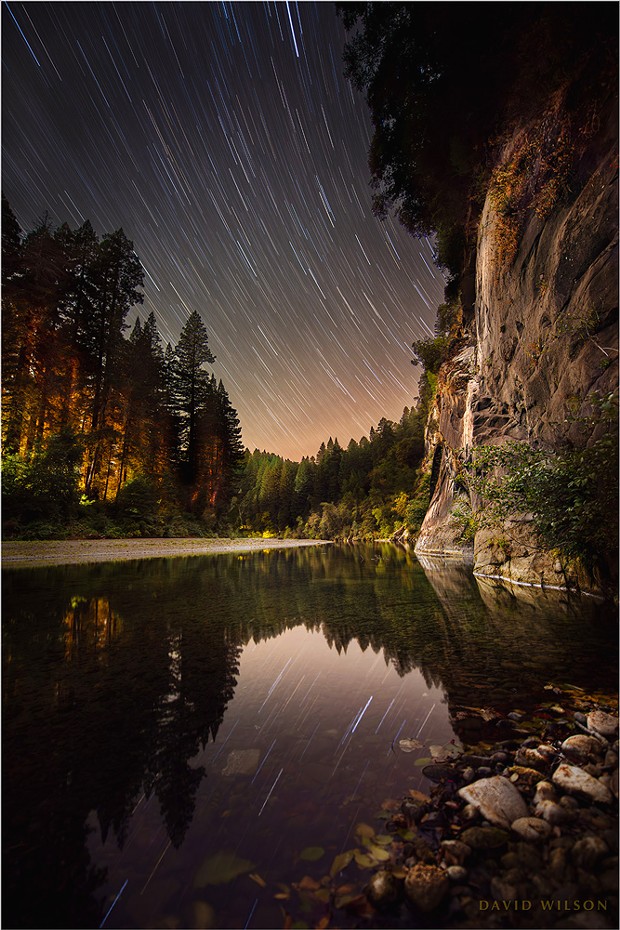
The South Fork Eel River, giant redwood trees and wheeling stars overhead making streaks over the course of a 21:02-minute exposure. The reddish light in the trees is from dwellings across the river. Redway Beach, Redway, California. Oct. 6, 2023.
[
{
"name": "Top Stories Video Pair",
"insertPoint": "7",
"component": "17087298",
"parentWrapperClass": "fdn-ads-inline-content-block",
"requiredCountToDisplay": "1"
}
]
I grew up in Southern Humboldt but somehow had only been to Redway Beach once or twice, and never in the last 30 years. It's accessible to the public from Beach Road, but I was guided here this time by my sister-in-law Samantha Wilson and my nephew Henry. Sam has a spa and bed and breakfast across the river called My Humboldt Abode, located at the Groves at Redway Beach. The three of us sat together and watched the stars slowly slide by while I photographed.
Sitting out there for a couple of hours, it was apparent to the naked eye how quickly the stars slipped across the sky. They seem still enough at any given moment, but over time one notices them sliding past the trees and sinking beneath the horizon.
The accompanying photograph was a 21-minute exposure, with the shutter open and the camera taking the picture for the duration. It shows how far the stars moved, from the moment I opened the shutter to the instant I closed it, as they sank toward the western horizon over 21 minutes. Their paths made light trails because while the shutter was open, the sensor was recording their light every moment as they moved across its field of view; so, rather than being pinpoints of light, the stars' movement turned their paths to streaks of light.
To us as we sat there with the camera, the night looked darker than you see in the photograph, though we could see well enough to walk without tripping (mostly) once our eyes became accustomed to the darkness. One of a camera's superpowers is its ability to see in the dark using long exposure times. Because the shutter was open for so long, it allowed the sensor to record a lot more light than the human eye can perceive in real time. Think of it as light pouring in like water and filling the sensor up until the image was bright enough. It doesn't work that way for our eyes.
Though the stars made motion streaks, it isn't the stars moving around us. Their apparent movement is caused by the Earth itself revolving on its axis, changing our view of the heavens moment by moment. I say axis because Earth is a globe, and you can see the evidence of it in the curvature of the star paths in the sky. To the north, the stars' paths circle the northern polar axis, which happens to line up well with the North Star, Polaris.
In this photograph, we are facing close to west, where star streaks are setting in more or less straight lines (celestial objects set in the west). You can see this on the left side of the photograph, where the trails are straighter, while to the right you can see the star paths are curving in an arc to the right: those stars are north of west and are making a great arc around the North Star. If this photograph had included Polaris in the north, we would see the star trails circling it. But if I had included more sky to the southwest (to the left of this view), we would see the streaks arcing to the left, around the southern polar axis. The southern polar axis itself is beneath the southern horizon from our position in the northern latitudes. It's interesting that the paths of the stars in a photograph can tell you in which direction the camera was facing.
To keep abreast of David Wilson's (he/him) latest photography or purchase a print, visit www.mindscapefx.com or follow him on Instagram at @david_wilson_mfx and on Twitter @davidwilson_mfx. David teaches Art 35 Digital Photography at College of the Redwoods.
more from the author
-
'All Happy Now' Beneath the Milky Way
- Sep 29, 2022
-
Some Coming Attractions
- Mar 17, 2022
- More »
































